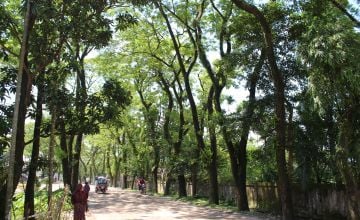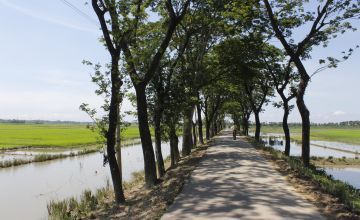
Knowledge Hub
On a road in Gowainghat, a region of Sylhet district in north-eastern Bangladesh, rows of trees on either side of the road soar high above the heads of the people walking along it, providing a natural umbrella of shelter from the midday sun across the whole road.
Known locally as the ‘Concern trees’, they’ve stood in this spot for more than 25 years. Following the recent historical rains and floods in Bangladesh last June, they stood their ground, protecting the road from flash floods which would otherwise have destroyed the raised roadway, due to speed and power of the rushing flood waters.
The road provides vital access for the local community, and had it been destroyed, it would have left people isolated and unable to reach local markets and schools.

What it takes to plant 100,000 trees
Rubel Talukder was working for Concern as a teacher in the area in the 1993 and remembers when the tree planting project started.
“The area is very hilly and when the rains came, they would rush down the hills and become flash floods, which washed away roads, homesteads and institutional grounds such as schools, health centres and government buildings. We could see that these floods were creating a huge problem for the local people.”
Concern responded by adapting an innovative integrated Rural Development Programme, which incorporated a number of components; education, savings, community-based self-help group, water, sanitation and hygiene, nutrition, and forestation and tree plantation.
It was decided to plant trees in three category areas; along roadsides, in homesteads, and in the grounds of education and healthcare facilities. Local communities and administrations were involved in the discussions and decision making on which roads and facilities were best for the tree plantation.
The work was started very gradually. Over the next 10 years, roughly 10,000 trees were planted every year, resulting in approximately 100,000 indigenous trees – rain tree, mahogany, chapel, shilkoroi, and local fruit trees - being planted over that time.

Community is key when it comes to caring for trees
“We adapted strategies for caring for the trees” said Rubel, who went on to become directly involved with the project in the early 2000’s.
“We identified some people from the community who were Concern programme participants, in consultation with the local community and government authority. We also set a selection criteria, for candidates from marginalised, minority and vulnerable groups. We provided wages for them from the project and we also collaborated with the World Food Programme, who supported us in providing wheat to the tree caretakers. Most of the caretakers were women, around 90%.”
The caretaking group, under a plantation supervisor, looked after the trees; separating them, providing water, fertiliser, fencing.
“There were two ultimate objectives, the most immediate was to create job opportunities for vulnerable members of the community, especially widows, and longer term to create protection for local roads, homes, and essential institutions from flash floods. Huge community involvement was ensured and it’s why those trees are still standing."
“Another impact of the forestation programme was when other members of the community who were not programme participants with Concern, saw their neighbours who were, planting trees around their homesteads, and the benefits – they were very, very motivated and encouraged and started to follow the Concern plantation strategy. They bought trees from the general market and they planted those trees in their homesteads,” added Rubel.
Still standing after all these years

Almost 30 years later, it’s estimated that around 70% of the trees planted are still standing.
Nature-based solutions, such as planting trees, are commonly used to reduce the risk of events, such as flash floods. They’re effective, cost efficient, scalable and widely applicable. In the case of forestation, protecting and restoring forests can stabilise soils and slow water runoff.
In June last year (2022) Bangladesh experienced some of the worst flooding in almost a century. Concern, along with its local partner, Friends in Village Development Bangladesh (FIVDB) launched an immediate response in Sunamganj district in north- eastern Bangladesh, adjacent to the Sylhet district. Concern is continuing to work closely with local partners and communities in emergency recovery in the months following the floods.
Other ways to help
Donate now
Give a one-off, or a monthly, donation today.
Join an event
From mountain trekking to marathon running, join us for one of our many exciting outdoor events!
Buy a gift
With an extensive range of alternative gifts, we have something to suit everybody.
Leave a gift in your will
Leave the world a better place with a life-changing legacy.
Become a corporate supporter
We partner with a range of organisations that share our passion and the results have been fantastic.
Create your own fundraising event
Raise money for Concern by organising your own charity fundraising event.





